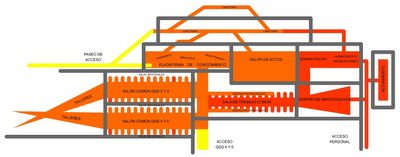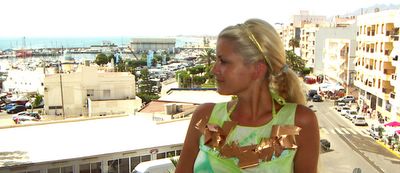
In a recent visit to the Science Museum in Barcelona, it was impressive to see the different kinds of brains within the animal world, presented like jewellery in their glass cases. Everyone agrees that the brain is a complex organ of thought and reason, as well as controlling many functions. The doctor, Carmen Antúnez, has already showed us images of the human brain in two different stages – of a newborn baby and an adult. (See below A TISSUE OF NEURONS I and TISSUE OF NEURONS II, both posted in July 2006). One is about to start its complex relationship with the world but the other has experienced a great deal on his journey through life.
Bearing this in mind, the question arises: under what conditions do scientists work with the brain? That is, what is their attitude of being observed? How is the brain stored, this precious organ that stores our life history? Undoubtedly, for the researchers at AlzheimUr, the brain represents a key to the future. With it, the scientists keep the hope to find more about the signs and evolution that affects the illness. One could think that the brain’s tissue is a language, still fairly unfamiliar. But what then? What method could be applied? Investigating the brain, are we able to be objective? In Jacque Lacan’s essay ‘The direction of the treatment and the principles of its power’ (1958), he questions the result of the analyst on the basis of “Who is speaking?” Although referring to psychoanalysis, his thoughts make us reflect on how questions are phrased. What is expected from the answer? Working with memories and tracing the past of the patient also raises questions about the connection between the brain and emotions. What makes us burst into tears? And, after crying, can we detect signs in the brain as a proof of that specific reaction?
Understanding the complexity of the brain, the typology of AlzheimUr’s Research Centre is designed in such a way as to stimulate communication and to create links between scientists, ideas and memories, with private and common spaces, crossing views and paths. From their respective research units, the scientists can exchange looks and gestures, crossing the green area that divides them, and observe each other at work; by the wet area, doing manual work or working in the dry area (computers). There is always certain awareness of the other, of collaborating.
Entering the Research Centre, the visitor, on the other hand, immediately feels the presence of their treasure, the BRAINS. This materia prima is stored in the Bank of Brains, which is made of a system of mobile shelving units of high density. The Bank is situated in a spacious and an open reception, with an indirect light that enters through the big windows and internal courtyards. With nature’s presence, the visitor is constantly reminded of life’s cycle and the notion of time. Within this atmosphere that expresses respect and security, the patient’s family is invited to participate in the work of the research and to consider the future donation of the brain to be studied.
With the cooperation and commitment of the family, patients, doctors and scientists, the Research Centre becomes a complex system of connections and with time, dense like the tissue of relationships that composes the nervous system of a mature adult.

















































































